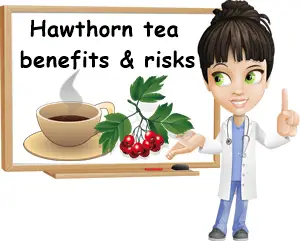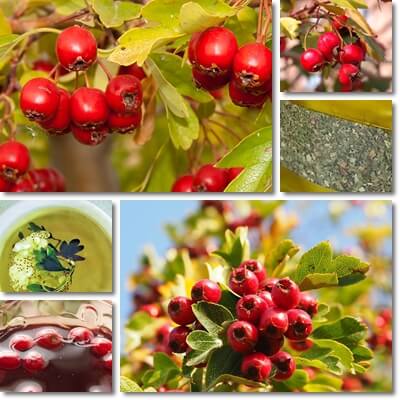A popular herbal remedy in Europe, hawthorn has been used therapeutically for centuries, primarily in the form of hawthorn tea made from berries, but also flowers, leaves, twigs or sprigs.
Hawthorn tea has excellent therapeutic effects, with scientifically proven blood pressure lowering properties and benefits for heart failure. Studies have further demonstrated hawthorn has anticoagulant effects, anti-atherosclerotic action and is an anti-arrhythmia agent.
Regular consumption of the tea actively supports cardiovascular function and advances cardiovascular health via biologically active antioxidants known as proanthocyanidins, as well as other flavonoids and phytochemicals.
What is hawthorn?
Hawthorn is a perennial shrub or small tree found throughout the temperate regions of the Northern hemisphere. There are several hundred different species of hawthorn, most, if not all, with edible berry-like fruit known as haws.
Hawthorn berries are commonly red, but species of hawthorn with red-brown, yellow, orange, blue, purple and black berries also exist. Hawthorn berries and other plant parts (leaves, leaf buds, twigs or sprigs and flowers) can be used therapeutically as tea or extracts, their primary uses being: cardiotonic, anti-hypertensive and anti-arrhythmic.
Also see the benefits of hawthorn berries.

Types of hawthorn tea
- Hawthorn berry tea made exclusively from haws, the fruits of the hawthorn plant, dried or fresh.
- Hawthorn leaf tea made exclusively from hawthorn leaves (dried, ground, coarse leaf material).
- Hawthorn blossom/flower tea made exclusively from fresh or dried hawthorn flowers.
- Mixed hawthorn tea made from multiple plant parts such as berries and flowers or leaves, buds, twigs or sprigs.
- Hawthorn tea mix made with hawthorn and other herbs, commonly hibiscus, rooibos or rose hips.
Also see the benefits of rose hip tea.
What does hawthorn tea look like?
The way hawthorn tea looks like depends on the plant parts it contains. Hawthorn berry tea is bright to deep red, depending on how concentrated it is.
Hawthorn leaf tea is amber to medium brown, while mixed hawthorn tea made from berries and other plant parts is an orangey-brown or reddish-brown. Hawthorn flower tea is a light amber color.
Hawthorn leaf tea is available in the form of individual tea bags or loose dried leaf material of a grayish-green color, and is typically coarse, not finely ground.
Hawthorn berry tea is available as loose material, with the dried, whole, chopped or crushed berries often being sealed in a plastic bag which is then packaged in a cardboard or paper package for better storage.
What does hawthorn tea taste like?
It tastes good. Hawthorn tea is a fairly pleasant-tasting tea, with tangy notes and sour, fruity as well as earthy, woody, herbal flavors. The tanginess comes from the fruits, and so does the fruitiness.
The earthy flavors come from other plant parts commonly used to make hawthorn tea such as leaves, twigs or sprigs. Most people prefer hawthorn berry tea to hawthorn leaf tea because of its sharp, astringent, fruity taste.

Hawthorn tea uses
Therapeutic uses
Hawthorn tea supports cardiac function and can be consumed for its cardiotonic properties. Hawthorn tea, especially the berry tea, is an excellent adjuvant in hypertensive disease, and has anti-arrhythmia properties. The tea reduces high heart rate and lowers blood pressure via vasodilation, improving circulation which boosts relaxation and reduces stress, as well as exerts an anxiety effect, all via proanthocyanidin antioxidants.
Cosmetic uses:
Hawthorn berry tea is rich in antioxidants and can be used topically to combat oxidative stress in skin cells and prevent and limit free radical damage. Hawthorn berry tea is also an astringent, helping tighten skin for a more youthful appearance. Used regularly as a face wash, or by applying the used tea bags to the face, it exerts an illuminating, anti-blemish effect, and hydrates the skin. Antioxidants in the tea scavenge free radicals and help limit and repair cell damage conducive to premature aging.
15 Health benefits of hawthorn tea
Benefits for heart failure management
Hawthorn berry and flower tea act as cardiotonic agents, supporting the cardiac function by improving coronary blood flow, with benefits for heart failure and associated symptoms such as chest pain, low exercise tolerance, shortness of breath etc. (source 1, source 2).
Benefits for angina pectoris
Angina is chest pain and pressure caused by poor blood flow to the heart, and is a symptom of heart failure. Studies show bioactive components in hawthorn berry and flower and preparations such as hawthorn tea can help improve blood flow to the heart, strengthen the cardiac muscle and dilate blood vessels for better blood circulation, helping improve angina.
Heart tonic
Studies show hawthorn leaf and preparations such as extracts and tea have positive inotropic effects, mobilizing calcium in vascular endothelial cells by increasing calcium concentrations in the vascular cells and activating the release of intracellular calcium, increasing the strength of heart muscle contractions (source).
Benefits for high heart rate
Research reveals hawthorn berries and flowers and preparations made from them such as tea have negative chronotropic effects, decreasing heart rate.
Good for high blood pressure
Hawthorn berries, flowers and other plant parts, and preparations such as hawthorn tea, extracts and more, contain biologically active chemicals that inhibit angiotensinconverting enzyme (ACE) and phosphodiesterase, lowering blood pressure numbers.
Benefits for arrhythmia
Bioactive antioxidants in hawthorn plant parts and tea and other preparations have scientifically-proven anti-arrhythmic benefits, regulating heart muscle contractions and heart rate (source 1, source 2).
Anticoagulant properties with an anticlotting action
Preliminary research suggests hawthorn preparations such as tea and more may reduce blood coagulation parameters, contributing to lower risks of cardiovascular events caused by blood clots.
Diuretic properties
Hawthorn tea increases urine production with benefits for kidney health and high blood pressure. Increased urine output maintains normal kidney function which supports kidney health. Not just this, but increasing urine output ups the elimination of excess fluid in the body and excess sodium which actively helps lower blood pressure.
Cholesterol-lowering properties
Studies suggest hawthorn tea and other preparations have anti-hyperlipidemic effects, helping lower blood cholesterol levels.
Benefits for atherosclerosis
Hawthorn tea and other preparations have anti-hyperlipidemic effects, combat lipid peroxidation as well as reduce endothelial cells injury (source), contributing to benefits for atherosclerosis prevention.
Blood sugar-lowering properties
Hawthorn products such as extracts, tea etc. can decrease blood glucose levels and increase plasma insulin release from pancreas, contributing to anti-diabetic benefits (source).
Benefits for insomnia and anxiety
Hawthorn tea has scientifically proven vasodilating effects, improving circulation which boosts relaxation and reduces stress, contributing to benefits for sleep and an anti-anxiety effect.
Anticancer properties
Biologically active components in hawthorn berries and other plant parts and preparations made from them, including extract and tea, have demonstrated free radical-scavenging, anti-mutagenic, anti-proliferative properties.
Immune-boosting effects
Studies show hawthorn exerts direct immunomodulatory effects, boosting populations of various white blood cells (source).
Benefits for skin
Topical use of hawthorn tea or hawthorn material left over from tea-making produces an astringent effect, tightening skin for a more youthful appearance. Hawthorn tea used topically also has an illuminating, anti-blemish effect and exerts a reparative action at cell level.
What are the risks?
- Allergic reaction. It is possible to be allergic to hawthorn and preparations made from the plant, with the potential for anaphylactic shock.
- Medicine interactions. Therapeutic doses of hawthorn tea, extract, capsules and other preparations may interact with medicines used for treating high blood pressure, high cholesterol, heart failure, arrhythmia, anticoagulant medication etc. potentiating their effects.
- Low blood pressure. It is possible for hawthorn tea to cause blood pressure numbers that are too low, especially in normo-tensive individuals and those taking blood pressure-lowering medication.
- Digestive upset. It is possible to experience loose stools, nausea and mild digestive upset as a result of consuming hawthorn tea. Note: Digestive upset and a skin rash may indicate an allergic reaction.
- Other side effects. It is possible to experience lightheadedness, dizziness, sweating and palpitations as a result of consumption of hawthorn tea due to its cardiac effects.
